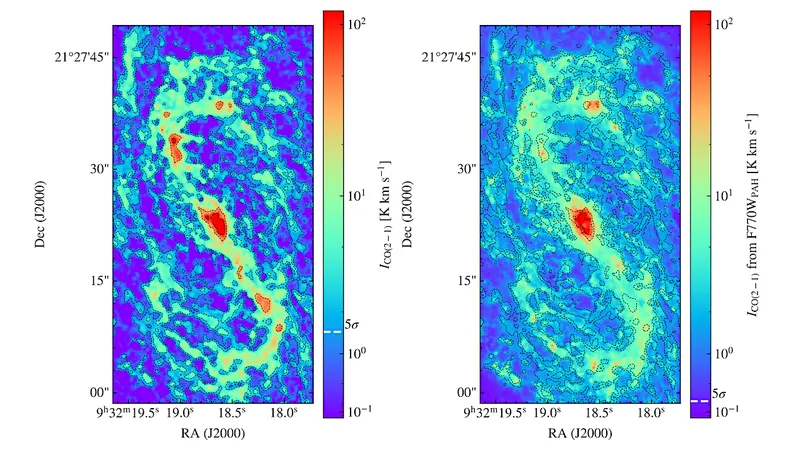
Unlocking the Cosmic Symphony: The Interplay Between Polycyclic Aromatic Hydrocarbons and CO(2-1) in Star-Forming Galaxies
2024-10-10
Author: William
Introduction
Recent groundbreaking research utilizing data from the Atacama Large Millimeter/sub-millimeter Array (ALMA) and the James Webb Space Telescope (JWST) has revealed intricate connections between carbon monoxide (CO(2-1)) emissions and polycyclic aromatic hydrocarbons (PAHs) in star-forming galaxies. This study enhances our understanding by significantly expanding the sample size analyzed, covering 66 nearby galaxies at an unprecedented resolution of around 100 parsecs.
Findings and Implications
By examining regions where molecular gas is abundant, researchers have unearthed strong correlations between CO(2-1) and PAH emissions, particularly at wavelengths of 3.3 microns, 7.7 microns, and 11.3 microns, as measured with JWST's F335M, F770W, and F1130W filters. The analysis led to the derivation of power law relationships between these emissions, with indices ranging from 0.8 to 1.2. This range suggests that variations in the observed CO-to-PAH ratios across different regions are relatively mild.
Intriguingly, the study indicated that CO-to-PAH ratios in areas surrounding HII regions—where star formation is particularly active—are quite similar to those found in more diffuse regions of galaxies. However, HII regions exhibited higher intensity levels for all measured tracers. In contrast, the centers of galaxies displayed even greater intensity and enhanced CO-to-PAH ratios compared to the disks of the galaxies.
Galactic Dynamics and Characterization
Further analysis revealed that the CO normalization at fixed PAH intensity varies between individual galaxies. Specifically, a 0.19 dex scatter was noted, with this normalization showing an anti-correlation with the specific star formation rate (SFR/M*) while correlating positively with stellar mass. This observation points towards a complex interplay influenced by galactic dynamics and the physical conditions present in different regions.
Future Perspectives
To facilitate future research, the scientists proposed a practical approach for estimating CO(2-1) intensity based on PAH emissions, thus leveraging JWST's exceptional sensitivity and resolution for tracing cold gas throughout the cosmos.
This study not only deepens our understanding of molecular gas dynamics in galaxies but also hints at the potential for unmasking the evolutionary paths of star formation across the universe. With continued advancements in astronomical technology, we may soon uncover even more secrets about the intricate dance of elements that shape our galaxies.
Conclusion
Stay tuned for further revelations as we dive deeper into the enigmas of the cosmos!









 Brasil (PT)
Brasil (PT)
 Canada (EN)
Canada (EN)
 Chile (ES)
Chile (ES)
 España (ES)
España (ES)
 France (FR)
France (FR)
 Hong Kong (EN)
Hong Kong (EN)
 Italia (IT)
Italia (IT)
 日本 (JA)
日本 (JA)
 Magyarország (HU)
Magyarország (HU)
 Norge (NO)
Norge (NO)
 Polska (PL)
Polska (PL)
 Schweiz (DE)
Schweiz (DE)
 Singapore (EN)
Singapore (EN)
 Sverige (SV)
Sverige (SV)
 Suomi (FI)
Suomi (FI)
 Türkiye (TR)
Türkiye (TR)